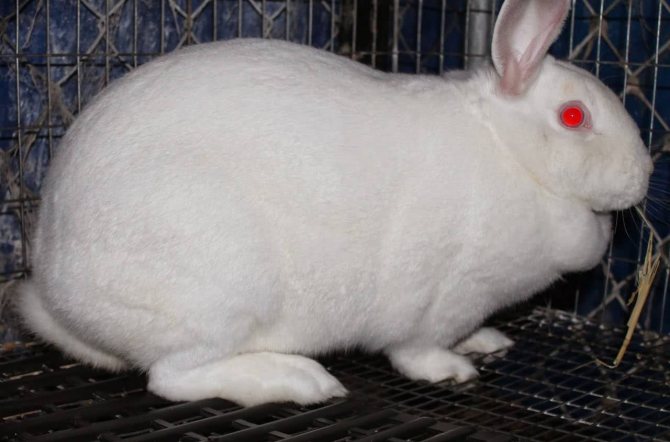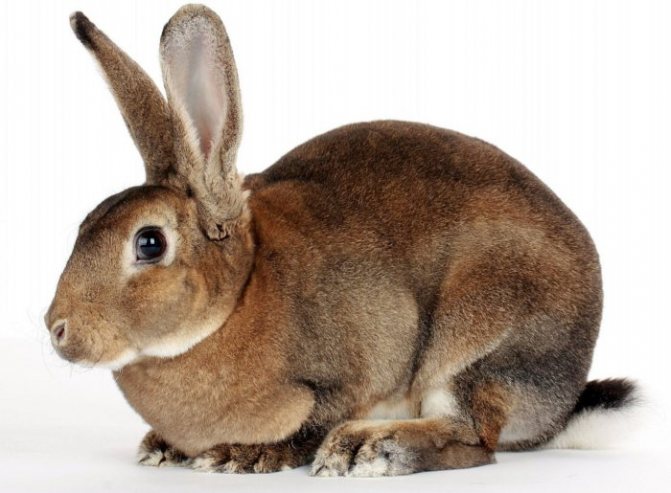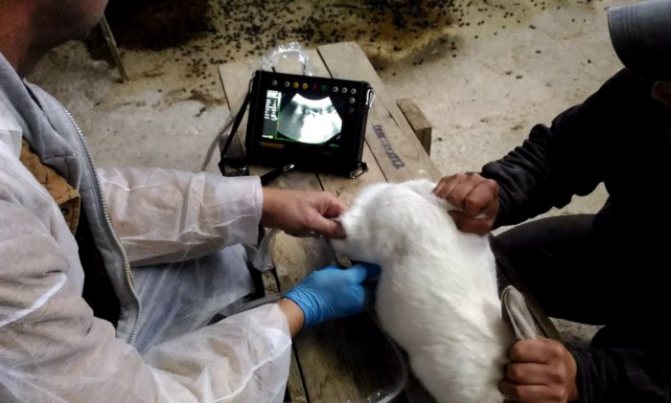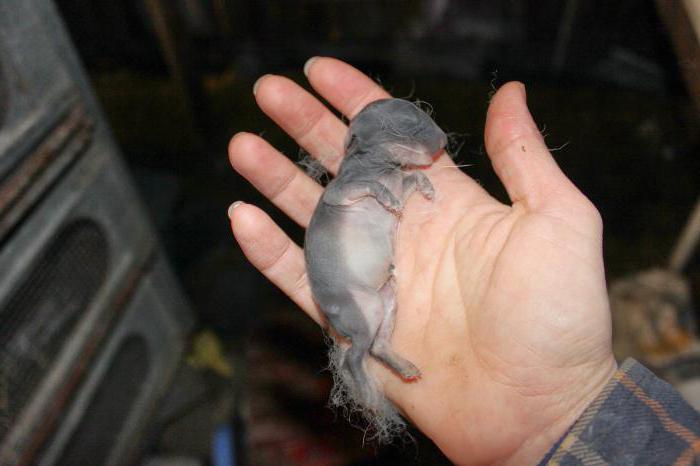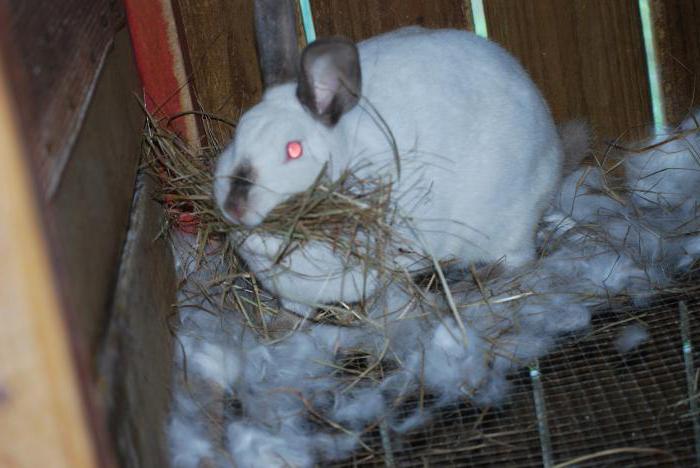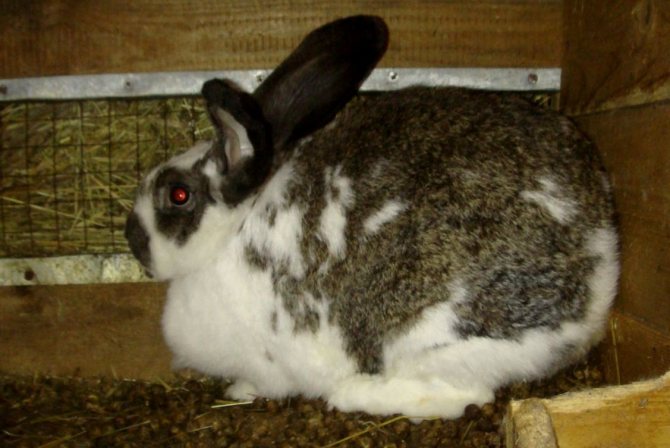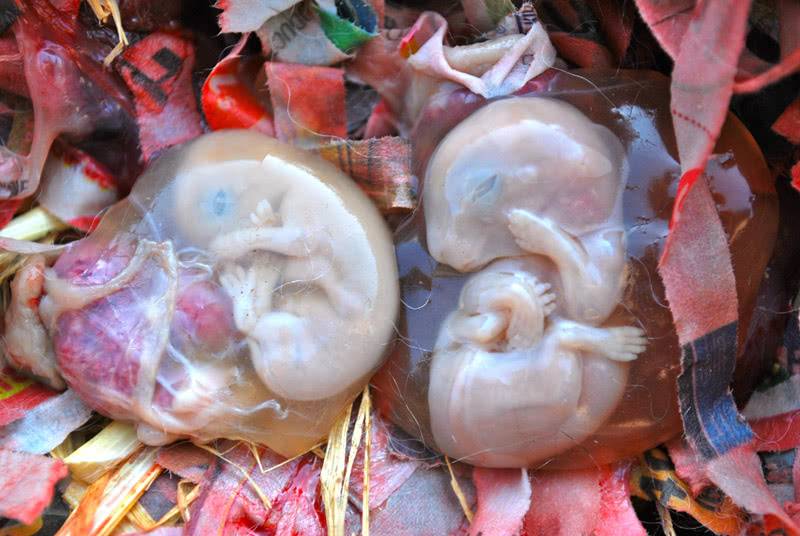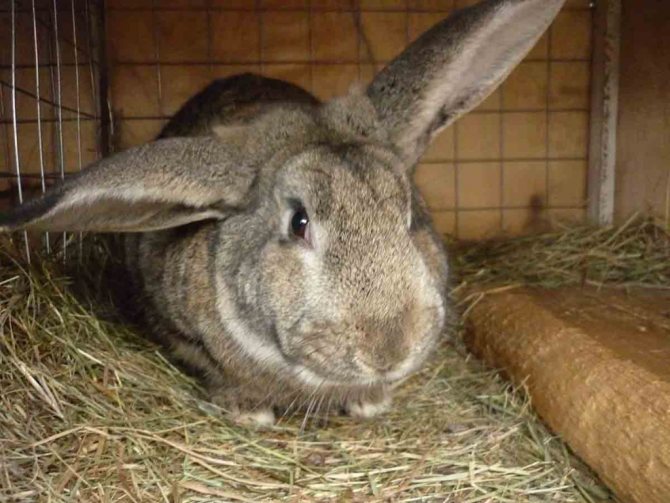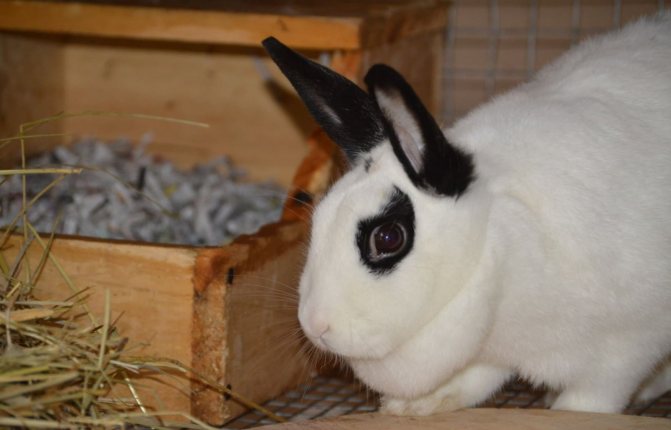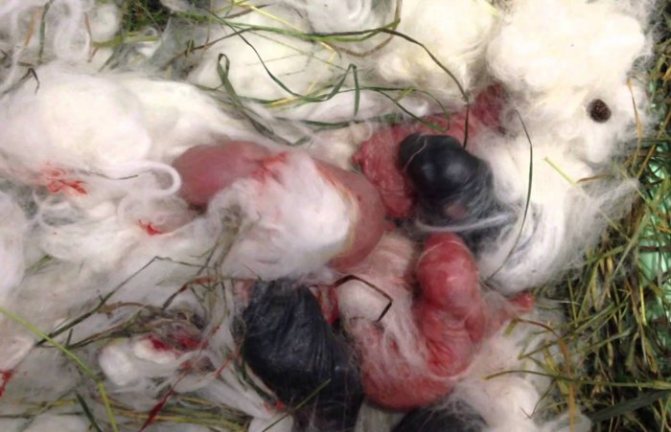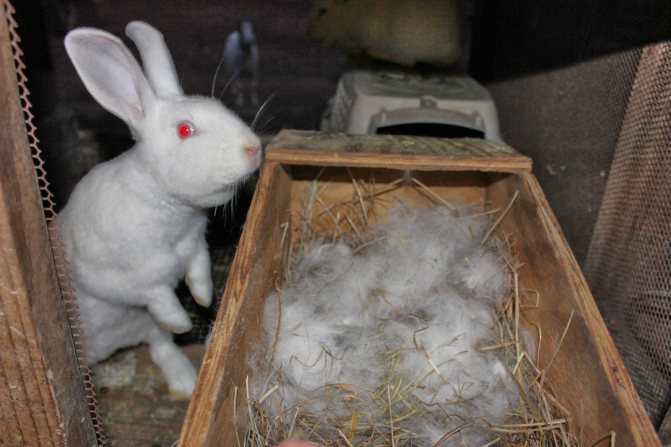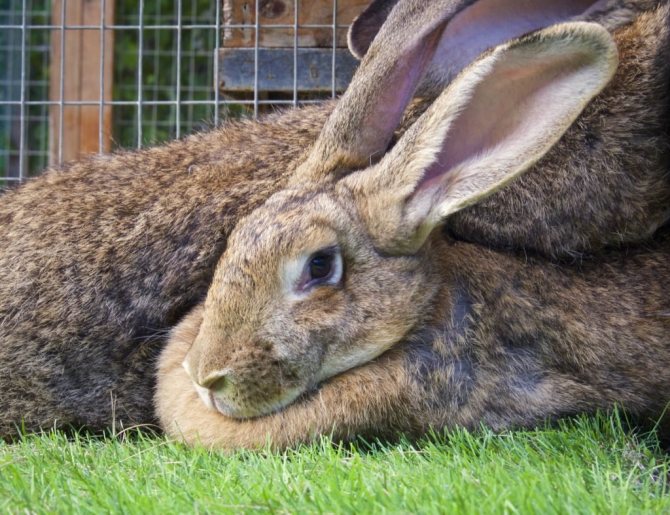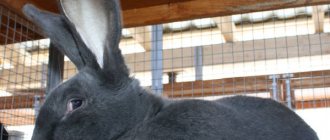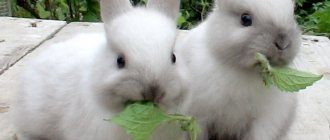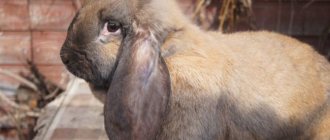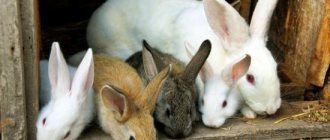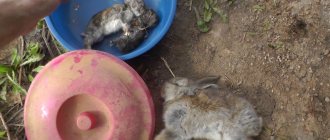- the main
- Breeding
If a person first decided to start breeding rabbits, then he has many questions. Interested, for example, how long does a pregnant rabbit walk? How is the birth of a rabbit going, how can I help her during pregnancy? It is unrealistic to predict all the risks, but it is possible to provide care and improve living conditions.
Rabbits are fertile animals that produce offspring 3-5 times a year. Rodents of large breeds are ready to mate at 6 months, and small breeds at three months. The main thing when crossing is to prevent the selection of closely related partners, otherwise the birth of rabbits will be under threat
Features of the rabbit pregnancy period
Rabbit pregnancy or fertility is the most crucial stage after mating. It lasts about a month. But there are many nuances that need to be considered in order for everything to go well.

During the fertility period, several important stages are noted:
- The date of mating and the first weeks after it. The first 14 days after mating, the conditions of keeping and feeding the females practically do not change. It is only recommended to make sure that the rabbit does not overeat - does not gain excess weight.
- 2 weeks after mating, the female is palpated to determine pregnancy. If the fertility is confirmed, then from the 15th day, the amount of hay and pelleted feed is gradually increased.
- On days 21-26, it is worth feeding the rabbit more. Due to the squeezing of the stomach by the rabbits, she will eat in smaller portions, but more often. Sometimes the female at this time already begins to "nest" - she scratches the bottom of the cage, carries a litter, begins to nibble the fluff out of herself.
- 25-29 days of pregnancy - transfer of the rabbit to a cage with a queen cell or installation of a brood nest.
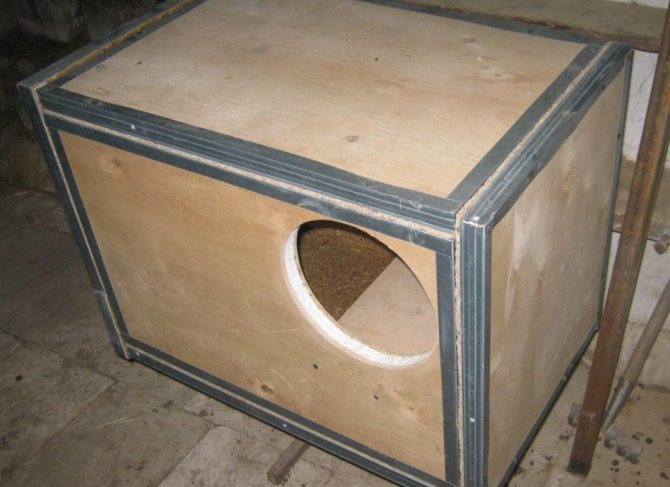

An example of a portable mother liquor
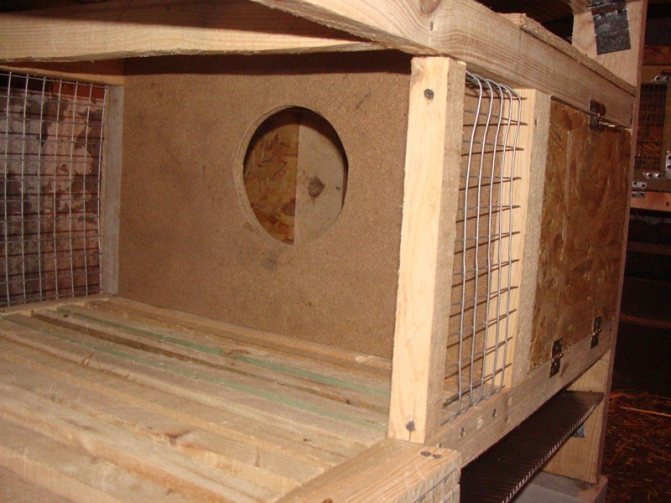

An example of a stationary uterine nest
You can use metal and wooden mother liquors. The main thing is that the nest fits in size - the rabbit is placed, there is room for bedding. They must be disinfected before use.


- 30-31 days - the expected time of birth of rabbits. It is on these days that the happy moment of the appearance of offspring in rabbits comes. Bunnies are able to give birth to up to 18 rabbits in one litter.
- Date of birth in fact and the number of babies in the litter. Newborn rabbits are born naked and blind. The average weight of a cub is about 60 grams. Don't be intimidated by being too small. In almost a month, babies gain almost 500 grams of weight, are covered with wool.
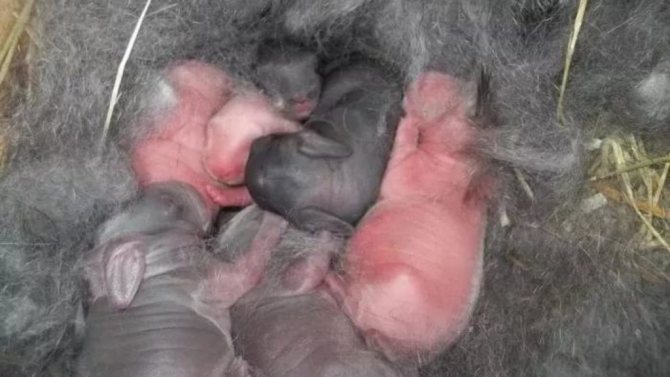

Newborn rabbits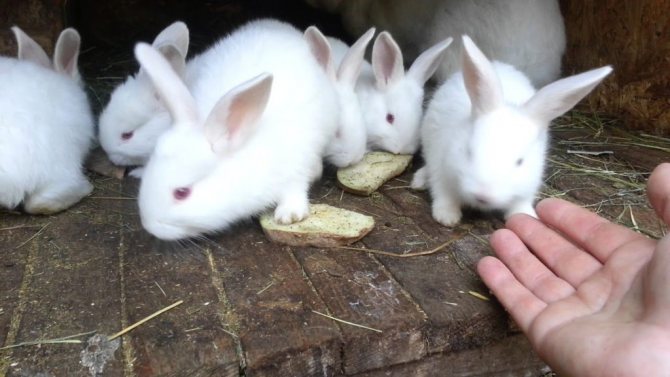

Rabbits at the age of 1 month
How rabbits give birth
In a rabbit, labor takes about 15-30 minutes. In some cases, five minutes, others one hour. In rare cases, the timing is a day or more. The okrol of the rabbit is accompanied either by a disorderly release of fetuses from both queens, or one uterus is released, and after a while the other.
The okrol process can be interrupted for several hours, sometimes days. This is a feature of rabbits.
Okrol is accompanied by the release of fetuses and placenta, the so-called children's place of rabbits. It is believed that the rabbit gave birth to baby rabbits after she independently bites off the umbilical cord that connects the fetus to the mother's uterus.
How to determine if a rabbit is pregnant
| Methods for determining fertility in a rabbit | |||
| 1.Visual control | 2.Monitor weight changes | 3 animal palpation | 4.Ultrasound diagnostics |
| The behavior of a pregnant female changes. She becomes quiet, careful, does not allow the male. Sometimes it reacts very aggressively to the owner. A distinctive feature - the rabbit begins to "nest" (carries hay in her teeth, pinches the fluff out of herself). Often, the expectant mother begins to throw away the usual food from the feeder, thereby making it clear that it is time to change her diet. In addition, she begins to drink more. | The rabbit is weighed before mating and in the first two weeks of the expected pregnancy. She will gain weight - about 200 - 400 grams in the first 14 days. | They spend not earlier than the tenth day after mating (so as not to harm the animal and babies in the womb). It is better to have an experienced farmer or veterinarian palpate the rabbit. For novice breeders, practice first. With one hand they hold the female by the ears and the scruff of the neck, with the other they probe both sides of the animal. The offspring in the womb at this moment is felt like small bunches of grapes. The lower abdomen of the rabbit is dense, the horns of the uterus become large. | With the help of an ultrasound machine, it is possible with a 100% guarantee to confirm the fact of fertility from the sixth day after fertilization. The method involves the transportation of animals to a veterinary clinic. Therefore, it is not justified when breeding a large herd of animals on a farm. It is also impossible to carry out at home. |
Preparation
Breeds of decorative rabbits
The puppet period, depending on the type of female, can last 26-35 days. Females of large breeds carry rabbits for a longer period. The most important condition for successful childbirth, obtaining a full-fledged offspring is high-quality nutrition for the expectant mother, along with the rabbit.
Females need to be fed with more succulent feed and high-calorie crops (grain, beans). If hay is served, it must be prepared according to the rules. The organism of the pregnant uterus rapidly gives up useful elements to the embryos, their deficiency should be replenished. The expectant mother should receive vitamins and minerals. It is especially important to replenish calcium.
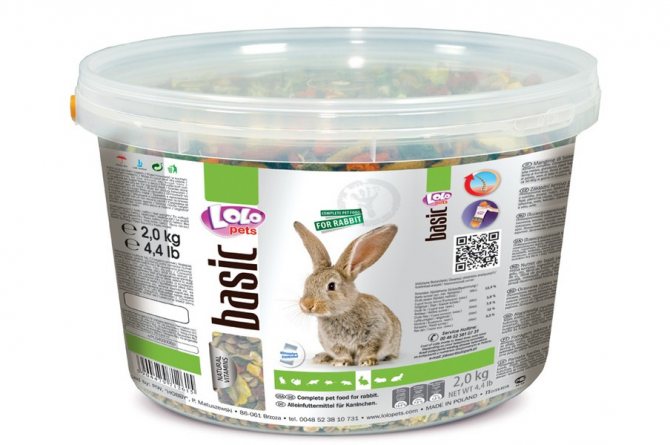

Vitamins for the rabbit
You can give biological additives and crushed calcium gluconate tablets together with wet mash, add to the drink. The tablets and a piece of regular chalk can simply be placed in a rabbit cage: it will nibble as much as needed. Rabbits need to create a quiet, comfortable environment. They should not be removed from the cage unnecessarily.
If you need to move the female, then proceed as follows:
- lure with food so that you do not worry;
- take by the withers;
- support from below.
If the female is already raising a litter, she should be placed in a young cage about 5 days before the time comes to give birth. It is imperative to separate mother and children. You should not place the uterus in another cage, you need to wash the one in which it lived before. Pre-disinfect, lay fresh, not hard straw and return it back to "home".
In how many days does the rabbit begin to build a nest - from crumpled straw and her fluff, the female builds a warm corner for the rabbits per day. It is important not to distract or disturb her. Can't be picked up or taken out into the street. It is especially bad if foreign odors act on the rabbit:
- cosmetics;
- tobacco;
- alcohol, etc.
Important! During childbirth, all the senses of the uterus are sharpened to the limit. Childbirth will be more successful if, after the rabbits are transplanted into the cage, the mother (maternity) is made and placed. It can be a box made of plywood 40x50 cm, 35-40 cm high. It is necessary to make an entrance 15x15 cm in size. Install the birth-bed 15 cm from the floor surface of the cage.
The mother may be different. For example, hanging ones are comfortable, because they are easier to clean.There is no general opinion among breeders about the need for a birth birth. Some generally consider it superfluous, or build an ordinary partition. Others advise using the birth ward exclusively in winter so that the born rabbits do not die. Still others believe that a childbirth is needed regardless of the season.
The brood will protect the rabbits from frost in the winter. Natural conditions are simulated in it, because the mother must give birth to offspring and raise them in a rather narrow, dark hole. The rabbit builds a nest right in the mother liquor. The top cover is made removable to perform the required manipulations. When it's warm, they take it off.
A second drinker must be placed in the birth center before the okrol, this is very important. Lambing rabbits at home for beginners will not be a problem if you follow the advice of the pros. The owner must prepare the nest with the rabbit.
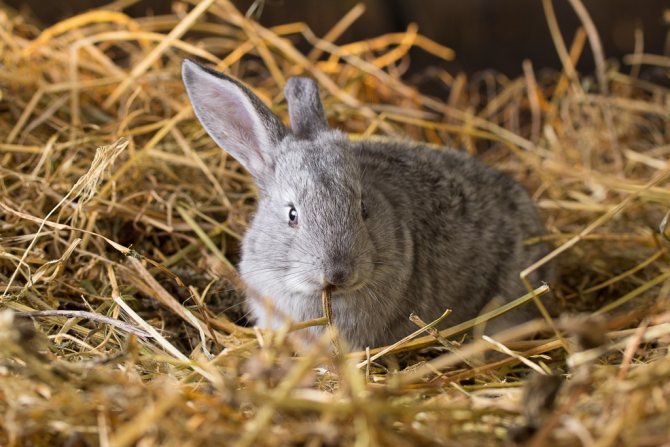

Preparing the nest
How long does a pregnant rabbit walk
Rabbits have a fertility rate of 28 to 35 days. The exact number of days depends on breed, litter size, female age.
The female giant rabbits are in position - 27-28 days, the Californian - 30-31 days, and the representative of ornamental breeds bears offspring - 30-32 days.
Also, do not forget that the greater the number of cubs in the womb, the sooner they will be born.
Rabbits that will be lambing for the first time usually give birth later than their "eared colleagues", who have already brought lambing 2-3 times.
When to mate a rabbit again
Now there is an answer to how rabbits give birth, how much they walk pregnant, it remains to figure out their uniquely rapid reproduction until the end.
High fertility is explained by their physiological characteristics, of which there are several.
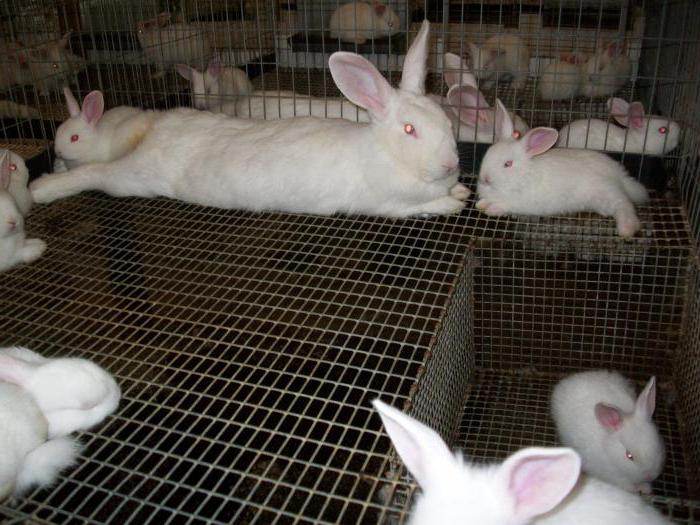

- Rabbits reach sexual maturity at 5-8 months.
- Pregnancy lasts 30 days.
- The next day after giving birth, the rabbit again enters a state of hunting. Feeding some of the rabbits, she can bear a new offspring. At 28 days, the first offspring is taken away from her, and after a couple of days she gives birth to new rabbits. Theoretically, a rabbit can bring 11-12 offspring per year.
- The female rabbits give birth in one birth to 6-15 rabbits.
- Rabbits can be slaughtered for meat at 5 months, the weight will be at least 3 kg.
Caring for a pregnant rabbit
The main thing when caring for a rabbit in position is proper feeding and keeping conditions. There are several aspects to keep in mind:
- A complete diet of the female succumb.
- Clean, well-groomed cage.
- Control of temperature, humidity, air purity in the room where the animal will be kept.
- No irritation, no stress, no bright lighting.
- Timely equipment of the cell with the uterine compartment.
- Do not disturb the female again unnecessarily.
How to properly feed a pregnant female
A pregnant female must eat properly to ensure the development of full-fledged offspring. It is necessary to make sure that the rabbit receives the right amount of high-quality and high-calorie food, according to the needs of this period, and also monitor the availability of fresh clean water in an unlimited volume.


In the second half of pregnancy, silage and bulk feed are removed from the diet, replacing them with carrots to meet the body's needs for carotene. A couple of days before the expected birth, food is reduced by half to prevent mastitis and an increase in acidity in the animal after birth. After okrol, for two weeks, the amount of food is increased, gradually bringing the volume to the usual rate.
In winter, the female cat is fed with sprouted grains and vitamins. Nutrition should fully meet the needs of the body, but care must be taken not to overfeed or cause obesity in the animal.
For rabbits that will give birth for the first time, they give food 15-18% more than others, since their body is still growing.


Recommended food norms for a pregnant rabbit
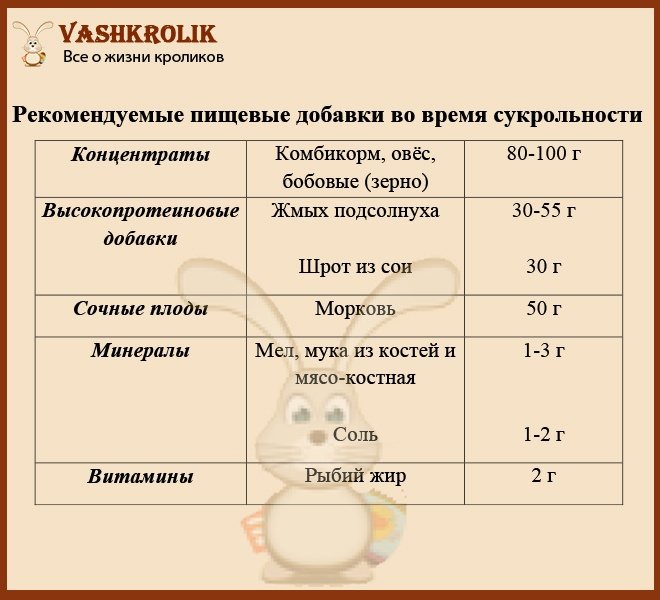

Recommended supplements during pregnancy
How should a rabbit's cage be equipped before rounding
The rabbit's cage is placed in a place protected from drafts and noise. If childbirth takes place in the summer, then the dwelling must be darkened from light. The temperature should not be more than + 33 + 35 C. In the cold season, the dwelling should be well insulated.
Before giving birth to cubs, the female's cage must be equipped with a uterine compartment - a nest. In it, the animal will curl up and feed the rabbits. This can be a portable box with a hole or a cage with a partition. The choice of the type of construction of the mother liquor falls on the rabbit breeder and its capabilities.
The main thing is that the nest conforms to certain rules:
- the dimensions of the maternity ward should exceed the length and width of the rabbit by 10 centimeters;
- it must be clean and disinfected before use;
- the bottom is lined with straw or sawdust;
- it must be set on the 26th day of pregnancy, so that the female can get used to it and equip it (pull up the fluff, fold the hay in her own way).
Preparing the cage for the period of labor in time
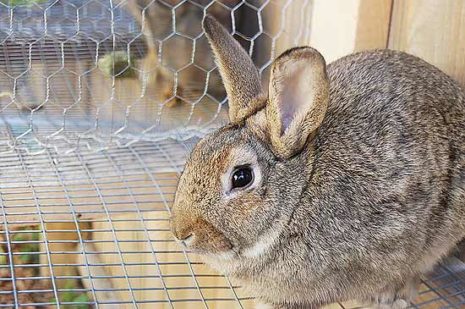

The basic rule for preparing a place for future birth is to create a separate queen cell in a cage, where the rabbit can retire and hide the babies. The farmer should also have access to the mother liquor (separate door) during subsequent harvesting and identification of dead rabbits.
Between the queen cell and the cage, it is necessary to build a small threshold (7-10 cm) so that small, immature rabbits do not fall out of the warm nest. Access to the nest is closed during pregnancy and opens only a week before the expected birth. This measure is necessary so that the female does not mistake a separate compartment for the toilet and begins to prepare the nest just before giving birth.
The cell and mother liquor must be pre-treated with an antiseptic (hydrogen peroxide, potassium permanganate). Throughout pregnancy, it is recommended to regularly change hay to prevent mold and mustiness. The fungus is very dangerous for both adult rabbits and future rabbits.
Problems associated with pregnancy
When breeding, rabbit breeders often face a number of problems that arise when rabbits bear offspring.
Among them, the most common are:
- Mastitis is a bacterial infection of the mammary glands of an animal, which occurs in the absence of hygiene during maintenance or as a congenital defect in the structure of the glands themselves.
Symptoms: inflammation, swelling, redness of the nipples, fever, lethargy.
Perhaps - blue glands, which requires urgent veterinary care.
It is very bad if rabbit milk contaminated in this way is passed on to newborns. This can be fatal for them.
- Toxicosis - intoxication of the animal's body with hormonal changes. Mostly females of Polish, Danish and English breeds are affected. It is believed that the lack of the necessary nutrients in the diet is to blame. Symptoms: lethargy, weakness, decreased physical activity, sometimes convulsive symptoms, loss of coordination of movements.
It is worth remembering that toxicosis can very quickly lead to the death of an animal, so you should immediately contact your veterinarian and start treatment. - Eating newborn rabbits is a syndrome that eared females often suffer from. Reasons: lack of proper nutrition and watering, or lack of it, stress, fear, interference by strangers in the nest.
Why does the rabbit not get pregnant
Bunnies stop getting pregnant or are not covered at all for a number of reasons:
- mistakes of rabbit breeders that they incorrectly look after the animals and conduct mating incorrectly;
- excessive fear of animals;
- inbreeding (mating of related animals);
- the age of the female or male;
- overweight or underweight;
- nutrition with alkaloid containing feed, which completely suppress estrus;
- weather conditions - cold snap or very hot;
- decreased sex drive at the end of summer;
- molting;
- too frequent mating (according to the method of compacted roundabouts);
- death of cubs in the womb;
- false success;
- miscarriages;
- excessive artificial stimulation of estrus with hormones;
- individual characteristics of the body (anestria, nymphomania).
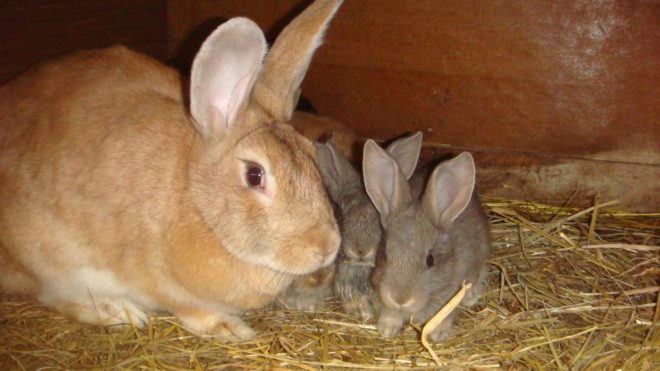

False pregnancy
False fertility for rabbits is a common occurrence. It is based on a violation of progesterone metabolism, on which the course of pregnancy directly depends. Such a phenomenon is possible only after sterile mating - sexual contact between a rabbit and a rabbit, when the egg does not combine with sperm.
The false pregnancy lasts for about two weeks. It is possible to accurately diagnose only with the help of ultrasound.
Symptoms of a false pregnancy in rabbits: - behaves in the same way as a felted female; - by the end of the second week from the expected conception, builds a nest, but does not give birth; - eat more; - the nipples increase in size, and rabbit milk may even begin to be released; - pulling the fluff out of the belly; - the genital loop swells and mucus is released from it.
By about day 20, all symptoms disappear.
Video PECULIARITIES OF THE BEHAVIOR OF THE BABY
How to cure a false pregnancy in a rabbit
- Hormone therapy. But we must remember that if the treatment helps, then the female will no longer be able to give birth to high-quality and completely healthy offspring.
- Culling. This is usually done if, during repeated mating, the female does not really become pregnant, and the purpose of the maintenance was precisely reproduction.
- Sterilization of the rabbit. To obtain high-quality skin or meat, the female should be sterilized (castrated). So she will quickly gain the desired weight and improve the condition of the coat, but at the same time problems in the genitourinary system of the rabbit can be avoided.
Blood in a rabbit's cage
Many, especially novice rabbit breeders, are panicked by the detection of blood in a rabbit's cage. Often, such discharge appears in the urine of the animal. There may be several reasons:
- Diet. The urine of the animal becomes blood-orange when the animal is oversaturated with beta-carotene, which is found in significant quantities in carrots, fodder beets, peppers, tomatoes, lettuce and spinach, as well as coniferous branches. If you remove the aforementioned products or reduce their amount, then in a few days the urine will return to its normal color and will no longer frighten the breeder.
- Lack of water. The urine becomes reddish when dehydrated on hot summer days, and also with heatstroke. At such a time, it is necessary to especially monitor the presence of water in the sippy cups and control the well-being of the eared pets.
- Stress. Rabbits are very shy, and any stressful situation can trigger the release of hormones in the body, which will affect the color of the discharge.
- Taking antibiotics. When animals are treated with antibiotics, red urine is a signal that their body is significantly weakened. In this case, you should not worry much, because after the treatment everything will return to normal.
More serious complications that are accompanied not just by a change in the color of urine, but by the presence of blood clots are:
- Uterine cancer. Non-castrated rabbits are at risk of getting sick. Treatment is surgical removal of the tumor or culling of diseased individuals.
- Spontaneous miscarriage.
- Infection of the genitourinary system of the rabbit.
Only a veterinarian can diagnose the exact cause.
Gestational age
Rabbits are fast-growing animals, the gestation period is 30 days, fetal movement is noticeable at the 4th week of pregnancy. Depending on the individual characteristics of the organism, the age of the pets, the period may increase or decrease by 3 days.


Be sure to read:
How to determine the gender of a rabbit: external differences, sex characteristics, behavior
Usually a female rabbit gives birth to 6-10, and sometimes 12-14 babies.Multiple droppings are undesirable, since the young are born weak. For the full growth of the cubs, the mother does not have enough milk, which negatively affects the survival rate and weight gain.
Duration of gestation
It is impossible to determine in advance the timing of childbirth, experienced rabbit breeders can only guess when to expect offspring.
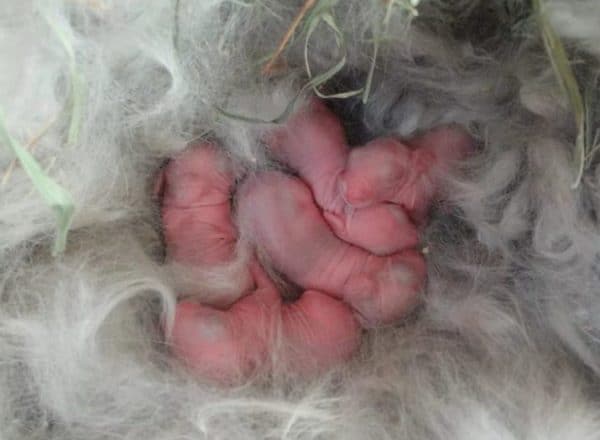

Newborn rabbits
For example, in primiparous rabbits, the first pregnancy is usually allowed at a later date, and multiple gestation ends in early birth.
Important! Premature birth is due to stress, fright, or poor conditions.
Signs of an approaching okrol
The rabbit signals that labor will soon begin with the following signs:
- behavior becomes very calm or vice versa - very aggressive;
- increased appetite;
- drinks a lot;
- actively equips the nest.
What to feed before okrol
| Mandatory components in the diet before okrol (daily rate) | |
| Sunflower cake | 30-50 grams |
| Compound feed, peas, beans and grains of other legumes, oats | 8-100 grams |
| Soybean meal | 25-30 grams |
| Boiled potatoes | About 100 grams |
| Hay (winter) / grass (summer) | 150-200 grams / 550-700 grams |
| Carrot | 150 grams |
| Bone meal or chalk | 1-2 grams |
| Salt | 1-2 grams |
| Crushed eggshell | 1-2 grams |
| Fish fat | 2 grams |
In winter, special vitamin and mineral complexes, sprouted wheat or oats are added. Before okrol, you should carefully monitor the volume of water in the drinker, because the need for it will increase.
How many rabbits a rabbit gives birth
On average, rabbits give birth from four to twelve rabbits per one lamb. Sometimes there are eighteen newborns. The number of cubs in rabbits is determined by the breed and age of the female, as well as by the conditions of keeping and the diet of the animals.
In dwarf rabbits, on average, up to 6 babies are born in a litter. Representatives of the middle weight category (from 4 to 6 kg) carry from 8 to 12 cubs. Giants can please the number of babies in the litter from 8 to 16.
The primiparous female usually has fewer litters.
Video Fostering / pregnancy of a rabbit and successful childbirth / birth of rabbits.
Features of childbirth
The birth of a rabbit is called okrol or lamb, and newborn rabbits are called droppings. The rabbit that is in the position is called pregnant or fledgling, and the one who has already given birth is called the roundabout, and they say that such a female has already rolled around.
Usually okrol takes place within 15-25 minutes, up to a maximum of one hour.
In the case when the rabbit cannot give birth for more than 60-70 minutes, you should contact your veterinarian. The more babies are expected, the faster labor will begin.
Does a person need help during childbirth
The main rule is not to interfere. Rabbits have a highly developed maternal instinct, and they perfectly cope with the process of childbirth and postpartum processing of cubs. Therefore, the role of a person is only to observe and control what is happening.
After nesting, you need to check the nest and remove if there are weak and dead babies. The check must be done very carefully so as not to frighten the female.
What to do if a rabbit cannot give birth
Signs that the bunny cannot heal:
- does not eat or drink;
- restless behavior;
- breathing heavily intermittently;
- the stomach becomes hard, tense.
It is worth immediately introducing a labor stimulant - oxytocin or pituitrin (injected intradermally under the scapula). If it does not help, then they urgently call veterinary help.
If, after stimulation, the rabbit spins, then she is given a drink of sweetened water in order to cleanse the body and speed up the exfoliation of the placenta.
At the birth of dead droppings, it is advisable to pierce the female with antibiotics.
Entering puberty, mating rabbits
When creating a breeding herd, you need to take into account that there should be 10 females for one male. It is advisable to keep two males in the breeding herd, because there must always be a backup.At the most crucial moment, the main producer may get sick, or several females need to be covered in a day.
Rabbits enter puberty early, but it is advisable to let them mate not earlier than 5 months, and males can be used as producers from 8 months.
In order not to miss the mating time, you need to periodically check whether the female has come to hunt. To do this, you need to take the rabbit out of the cage, put it on a flat surface and, raising the tail, examine the genital loop. When the rabbit is hunting, the loop is swollen, red. Since the light in the rabbitry is usually low, it is best to use a flashlight. The rabbit hunts for only 3 days, during which time you need to have time to fertilize her.
Always for mating, the rabbit is placed next to the male, and not otherwise. While she sniffs at a new place, the male quickly does his job. It is better not to leave them alone, mating occurs quickly, so it is better to observe that the act of reproduction has taken place. When the act has taken place, the male falls from the rabbit on its side and makes a characteristic sound. After mating, the female must be immediately picked up and returned to her cage. You can let the rabbit perform several acts, only on this day it is advisable not to add anyone else to him. If the rabbit is left with the male for a long time, it can exhaust him as a breeder, and they can fight.
If the rabbit's hunting time is missed, it's okay, in about a week she will come back to hunt.
Period after okrol
After nesting, the female eats the afterbirth, licks the newborns and transfers them to the nest, and then covers them with tugged down and feeds them. After that, the breeder should inspect the broodstock. The rabbit is separated from the babies and examined. It is necessary to remove dead rabbits (mostly die in the womb when infected). If the nest is stirred up, then it is corrected.
A primiparous eared mother may "forget" to build a place for the offspring or does not make the nest correctly, and also may not put the offspring there. In addition, they check whether the babies are fed. Fully fed cubs will lie quietly with noticeably rounded bellies.
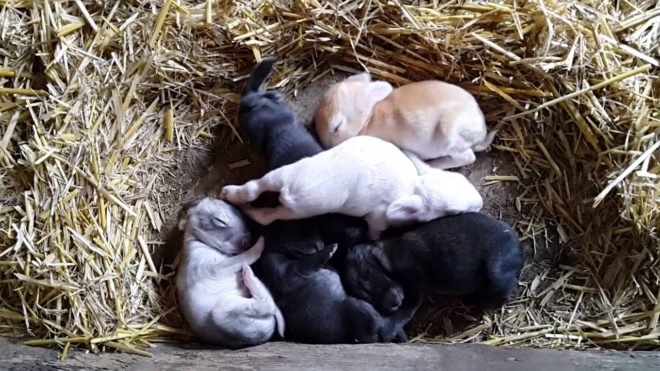

If the rabbits squeak, try to crawl and seemingly all have wrinkles, then, apparently, the female did not feed them or they do not have enough milk. If the female did not allow the little ones to eat, then they do it forcibly - they lay the nursing rabbit on its side and alternately put the rabbits on the nipples.
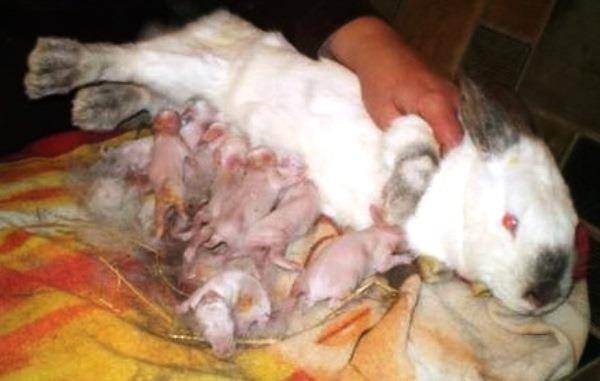

Forced feeding
After this, the female usually farther on herself copes well with the role of a mother - she feeds and takes care of the children. Sometimes you have to help for several days.
How to feed a rabbit after birth
After the rabbit has given birth, she needs good nutrition, because she will feed the babies with milk. And the speed of their growth and development will depend on the quality of milk.
| The diet of the rabbit after rounding a day | |
| Grass or legume hay / grass | 100-300 grams / 1000 grams |
| Sunflower cake | 40-50 grams |
| Sunflower cuts | 30-40 grams |
| Compound feed | Not more than 80 grams |
| Bone or meat and bone meal | 2-7 grams |
| Fish fat | 2-4 grams |
| a piece of chalk | 3-5 grams |
| Salt | Up to 3 grams |
| Feed yeast | 5-7 grams |
It is very good to feed lactating rabbits with mash - mixtures of vegetables, grain and cake. They perfectly raise milkiness.
| Examples of mixed mixes | ||
| №1 | №2 | №3 |
| alfalfa 0.6 units + 0.1 unit of bran + 0.1 unit of legumes + 0.1 unit of wheat grains + 0.1 unit of chopped vegetables | crushed alfalfa 0.6 units + crushed oats 0.4 units; | alfalfa 0.6 units + 0.3 units of barley + 0.1 units of corn kernels |
| Foods that stimulate lactation in rabbits | |
| In winter | In summer |
| Alfalfa hay | Carrot |
| Fruits of red-fruited mountain ash | Swede |
| Apples | Beet |
| Herculean flakes | Cabbage |
| Herbs (dill, sweet clover, parsley) | |
| Silage | |
| Zucchini | |
| Cucumbers | |
| Watermelon | |
| Melons | |
| Vitamin and mineral mixtures, powdered or sour milk | |
After about a month, each bunny will begin to taste food from her mother's feeder. For the young, steamed grain of wheat and oats, grated carrot and its leaves are added there.
Will the rabbit accept other people's rabbits
It happens that the rabbits bring too large a litter that they are not able to feed themselves. The eared "mother" has eight nipples, which means that she can feed so much. Sometimes females simply do not have milk or they have breast diseases that make breastfeeding impossible. In this case, the rabbits are placed in the nests with other females with small droppings.
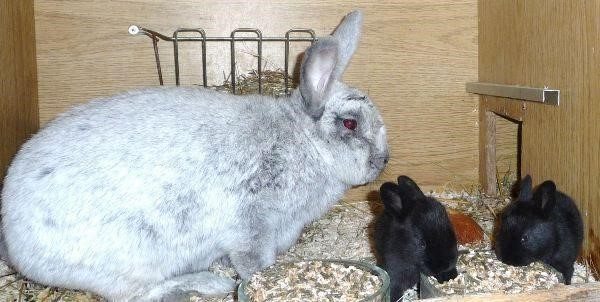

When transplanting rabbit offspring, certain rules must be observed:
- wash hands with odorless soap before transferring;
- do not use aromatic fragrances (colognes, perfumes, alcohol);
- check the age of the rabbits (the difference between litters should not exceed one week);
- put no more than three cubs in one nest.
Rabbits are isolated from access to the nests. Then the cubs are transplanted. The fluff is not blown off the animals. Bunnies are placed in the center of the litter so that they rub themselves against their relatives and nourish them with their scent. After 2-3 hours, the female is allowed in. It is necessary to observe her behavior for several days.
If everything is done correctly, then there are no problems, and the rabbit accepts other people's cubs as relatives, and successfully feeds everyone together.
Will the rabbit accept other people's rabbits
The litter should be added to another rabbit with multiple litters or if the woman in labor has died. This is not a bad omen. It is not difficult to plant it, since usually any rabbit accepts other people's cubs as her own, but a number of conditions must be observed.
The owner's hands must be clean, or better disinfected. Rabbits, which are given to another female, should be close in age to her relatives. It's good if the age difference is about 2-3 days. The animal, to which the cubs are planted, is temporarily taken out of the cage. And lonely rabbits are cleaned of the mother's fluff, rubbed with fluff from the nest of the new mother, who adopted them, and laid in the middle of the nest, and their relatives are placed around them. Then the female is returned back to the nest and her behavior is monitored.
If everything is done correctly, the animal will accept the rabbits and feed them as their own, regardless of the fact that they are of a different color and breed. If the conditions are ignored, the bunny may refuse or eat the bunnies.


